Blog & Latest Updates
Fly Fishing Articles
Insects by Common Name


> > Miscellaneous
Closeup insects from Miscellaneous
Ephemerella subvaria (Hendrickson) Mayfly Nymph View 3 PicturesThis is another peculiar brownish Ephemerella. It has double-banded tibiae (
View 3 PicturesThis is another peculiar brownish Ephemerella. It has double-banded tibiae (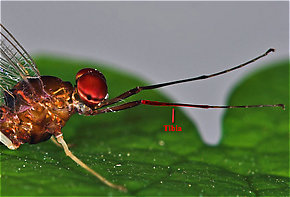 Tibia: A middle segments in the leg of an insect, located between the femur and the tarsus.) and prominent black-fringed tubercles (
Tibia: A middle segments in the leg of an insect, located between the femur and the tarsus.) and prominent black-fringed tubercles (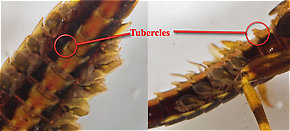 Tubercle: Various peculiar little bumps or projections on an insect. Their character is important for the identification of many kinds of insects, such as the nymphs of Ephemerellidae mayflies.).
Tubercle: Various peculiar little bumps or projections on an insect. Their character is important for the identification of many kinds of insects, such as the nymphs of Ephemerellidae mayflies.).
 View 3 PicturesThis is another peculiar brownish Ephemerella. It has double-banded tibiae (
View 3 PicturesThis is another peculiar brownish Ephemerella. It has double-banded tibiae (
The tibia of this Isonychia bicolor mayfly spinner is highlighted in red.

A few (not all) of the abdominal tubercles on this Ephemerella needhami nymph are circled. They are especially large in this species.
Collected February 7, 2004 from unknown in Wisconsin
Added to Troutnut.com by Troutnut on January 25, 2006
Added to Troutnut.com by Troutnut on January 25, 2006
Epeorus vitreus (Sulphur) Mayfly Nymph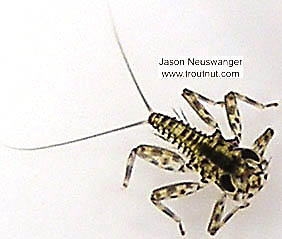 View 3 PicturesKey features I discerned with a microscope include that the femoral flange is sharp, and the first gill is not extended.
View 3 PicturesKey features I discerned with a microscope include that the femoral flange is sharp, and the first gill is not extended.
 View 3 PicturesKey features I discerned with a microscope include that the femoral flange is sharp, and the first gill is not extended.
View 3 PicturesKey features I discerned with a microscope include that the femoral flange is sharp, and the first gill is not extended.Collected February 7, 2004 from unknown in Wisconsin
Added to Troutnut.com by Troutnut on January 25, 2006
Added to Troutnut.com by Troutnut on January 25, 2006
Baetidae (Blue-Winged Olives) Mayfly Nymph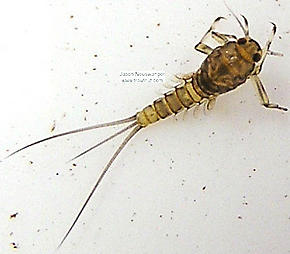 View 3 Pictures
View 3 Pictures
 View 3 Pictures
View 3 PicturesCollected February 7, 2004 from unknown in Wisconsin
Added to Troutnut.com by Troutnut on January 25, 2006
Added to Troutnut.com by Troutnut on January 25, 2006
Female Ephemerella invaria (Sulphur Dun) Mayfly Dun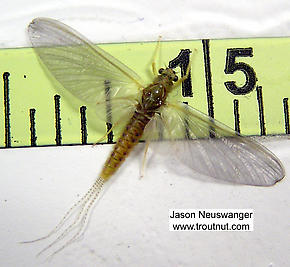 View 4 Pictures
View 4 Pictures
 View 4 Pictures
View 4 PicturesCollected May 23, 2004 from unknown in Wisconsin
Added to Troutnut.com by Troutnut on January 25, 2006
Added to Troutnut.com by Troutnut on January 25, 2006
Caenis (Angler's Curses) Mayfly Nymph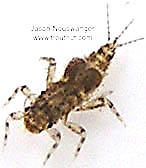 View 3 Pictures
View 3 Pictures
 View 3 Pictures
View 3 PicturesCollected February 7, 2004 from unknown in Wisconsin
Added to Troutnut.com by Troutnut on January 25, 2006
Added to Troutnut.com by Troutnut on January 25, 2006
Baetidae (Blue-Winged Olives) Mayfly Nymph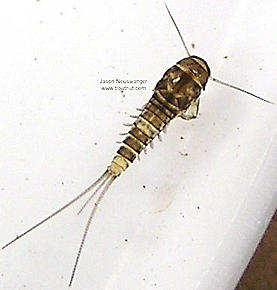 View 3 PicturesThis specimen has indistinct gill veinlets (Veinlet: Short insect wing veins connecting the major longitudinal veins to the wing margin.), a rounded seventh gill, and no bands on the tails.
View 3 PicturesThis specimen has indistinct gill veinlets (Veinlet: Short insect wing veins connecting the major longitudinal veins to the wing margin.), a rounded seventh gill, and no bands on the tails.
 View 3 PicturesThis specimen has indistinct gill veinlets (Veinlet: Short insect wing veins connecting the major longitudinal veins to the wing margin.), a rounded seventh gill, and no bands on the tails.
View 3 PicturesThis specimen has indistinct gill veinlets (Veinlet: Short insect wing veins connecting the major longitudinal veins to the wing margin.), a rounded seventh gill, and no bands on the tails.Collected February 7, 2004 from unknown in Wisconsin
Added to Troutnut.com by Troutnut on January 25, 2006
Added to Troutnut.com by Troutnut on January 25, 2006
Eurylophella (Chocolate Duns) Mayfly Nymph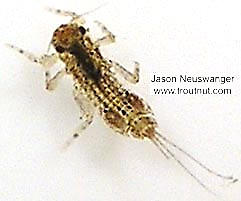 View 3 Pictures
View 3 Pictures
 View 3 Pictures
View 3 PicturesCollected February 7, 2004 from unknown in Wisconsin
Added to Troutnut.com by Troutnut on January 25, 2006
Added to Troutnut.com by Troutnut on January 25, 2006
Eurylophella (Chocolate Duns) Mayfly Nymph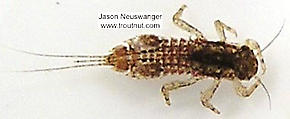 View 3 PicturesLooking at this specimen under a microscope revealed prominent sharp abdominal tubercles (
View 3 PicturesLooking at this specimen under a microscope revealed prominent sharp abdominal tubercles ( Tubercle: Various peculiar little bumps or projections on an insect. Their character is important for the identification of many kinds of insects, such as the nymphs of Ephemerellidae mayflies.). Also, abdominal segment 9 is distinctly longer than abdominal segment 8, meaning this is definitely a Eurylophella nymph.
Tubercle: Various peculiar little bumps or projections on an insect. Their character is important for the identification of many kinds of insects, such as the nymphs of Ephemerellidae mayflies.). Also, abdominal segment 9 is distinctly longer than abdominal segment 8, meaning this is definitely a Eurylophella nymph.
 View 3 PicturesLooking at this specimen under a microscope revealed prominent sharp abdominal tubercles (
View 3 PicturesLooking at this specimen under a microscope revealed prominent sharp abdominal tubercles (
A few (not all) of the abdominal tubercles on this Ephemerella needhami nymph are circled. They are especially large in this species.
Collected February 7, 2004 from unknown in Wisconsin
Added to Troutnut.com by Troutnut on January 25, 2006
Added to Troutnut.com by Troutnut on January 25, 2006
Eurylophella (Chocolate Duns) Mayfly Nymph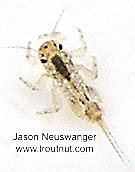 View 3 PicturesThis nymph is an extremely early instar (Instar: Many invertebrates molt through dozens of progressively larger and better-developed stages as they grow. Each of these stages is known as an instar. Hard-bodied nymphs typically molt through more instars than soft-bodied larvae.).
View 3 PicturesThis nymph is an extremely early instar (Instar: Many invertebrates molt through dozens of progressively larger and better-developed stages as they grow. Each of these stages is known as an instar. Hard-bodied nymphs typically molt through more instars than soft-bodied larvae.).
 View 3 PicturesThis nymph is an extremely early instar (Instar: Many invertebrates molt through dozens of progressively larger and better-developed stages as they grow. Each of these stages is known as an instar. Hard-bodied nymphs typically molt through more instars than soft-bodied larvae.).
View 3 PicturesThis nymph is an extremely early instar (Instar: Many invertebrates molt through dozens of progressively larger and better-developed stages as they grow. Each of these stages is known as an instar. Hard-bodied nymphs typically molt through more instars than soft-bodied larvae.).Collected February 7, 2004 from unknown in Wisconsin
Added to Troutnut.com by Troutnut on January 25, 2006
Added to Troutnut.com by Troutnut on January 25, 2006
Eurylophella (Chocolate Duns) Mayfly Nymph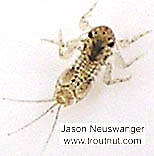 View 3 PicturesThis nymph is an extremely early instar (Instar: Many invertebrates molt through dozens of progressively larger and better-developed stages as they grow. Each of these stages is known as an instar. Hard-bodied nymphs typically molt through more instars than soft-bodied larvae.).
View 3 PicturesThis nymph is an extremely early instar (Instar: Many invertebrates molt through dozens of progressively larger and better-developed stages as they grow. Each of these stages is known as an instar. Hard-bodied nymphs typically molt through more instars than soft-bodied larvae.).
 View 3 PicturesThis nymph is an extremely early instar (Instar: Many invertebrates molt through dozens of progressively larger and better-developed stages as they grow. Each of these stages is known as an instar. Hard-bodied nymphs typically molt through more instars than soft-bodied larvae.).
View 3 PicturesThis nymph is an extremely early instar (Instar: Many invertebrates molt through dozens of progressively larger and better-developed stages as they grow. Each of these stages is known as an instar. Hard-bodied nymphs typically molt through more instars than soft-bodied larvae.).Collected February 7, 2004 from unknown in Wisconsin
Added to Troutnut.com by Troutnut on January 25, 2006
Added to Troutnut.com by Troutnut on January 25, 2006
Start a Discussion of Miscellaneous:
Top 10 Fly Hatches
Top Gift Shop Designs
Eat mayflies.
Top Insect Specimens
Miscellaneous Sites
Troutnut.com is copyright © 2004-2024 Jason
Neuswanger (email Jason). See my FAQ for information about use of my images.
 privacy policy
privacy policy
